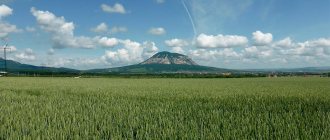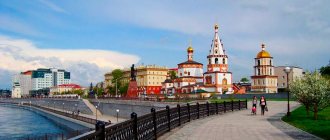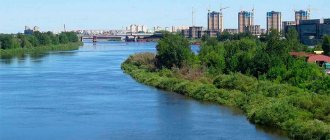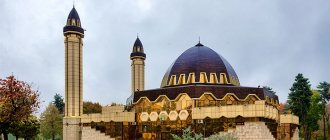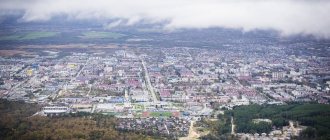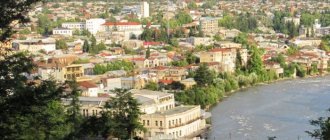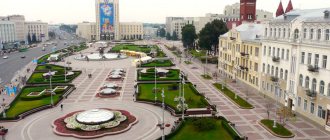| Sights Museums Where to go in the evening What to see in the surrounding area What to do in Arkhangelsk in winter with children Reviews and routes for tourists Where to stay in Arkhangelsk |
Arkhangelsk is one of the large regional centers in the north of the European part of Russia. The city has many monuments and museums, a large embankment and remarkable street architecture. Guests can enjoy cultural and entertainment venues, shopping centers, modern hotels and restaurants offering to discover new, northern tastes. Everything that a tourist can see in Arkhangelsk does not change or disappear in winter. The weather only creates its own scenery. You can travel here for 1 day, or for 2 or 3 days - it all depends on your time and desire to see certain sights.
Winter in Arkhangelsk passes with a good “minus”, the average temperature is -5...-16 °C. The weather is characterized by an abundance of precipitation and humidity, and is strongly influenced by the White Sea, which is 30 km from the city. In winter, the days are short, but there is no polar night, and the northern lights are a rather rare visitor: the city lies south of the Arctic Circle.
Attractions
The main attractions of Arkhangelsk are located along several coastal streets: along Troitsky Avenue , along the pedestrian Chumbarova-Luchinsky Avenue and the Northern Dvina embankment . The latter is 7 km long and completely encircles the central part of the city. It is decorated with dozens of monuments and wooden art objects, and ice sculptures appear in winter. This is one of the popular places for a walk, and in February, for example, it is a site for Maslenitsa.
Trinity Avenue in Arkhangelsk Photo: © dualia1
Lenin Square
Wide, spacious Lenin Square is central to Arkhangelsk. On winter evenings, the main city Christmas tree lights up here with bright lights. There is also a business center - the austere buildings of the Regional Assembly of Deputies, the Regional Government and the City Administration. The building of design organizations, now offices, stands out with 24 floors and a spire. The apt popular names “high-rise”, “candle”, “pencil” are addressed to him. The architectural ensemble of the square was formed in the 1960s, for which the old city blocks were completely dismantled.
In the center of the square stands a monument to Vladimir Ilyich , which became the last in the country (1988), and in front of the Regional Government there is an obelisk of the North with a Pomor and a deer, dedicated to the creation of the Northern Territory - a territorial unit of the first Soviet years. Closer to the embankment, at the intersection of the square with the street. Voskresenskaya established Zero Milestone .
Read more: Lenin Square in Arkhangelsk
Arkhangelsk New Year's Lenin Square Photo: © dualia1
Stele “400 years of Arkhangelsk”
An important symbol of the city is the stele “400 years of Arkhangelsk”, located on the embankment stairs in front of Gostiny Dvor. It was installed on the site where in 1584, by order of Ivan the Terrible, a fortress was erected on Cape Pur-Navolok. The stone stele resembles the bow of a ship or the wave with the wheelhouse of a submarine. Its top is decorated with an elegant forged element - Archangel Michael, the patron saint of Arkhangelsk. The composition with the stele consists of two columns with forged ends, standing along the edges of the staircase.
A hundred meters south on the embankment there is another memorial sign - “400 years of the founding of the Russian pilotage service . It represents a tribute to memory and respect to those who created the maritime history of the city. The monument is made in the form of the steering wheel and bow of a ship and is decorated with the North Star.
Read more: stele “400 years of Arkhangelsk”
Stele “400 years of Arkhangelsk” at Cape Pur-Navolok Photo: © dualia1
Monument to Peter I
The monument to Peter I stands in the middle of Petrovsky Square on the city embankment. The bronze figure has a height of 2.5 m and is installed on a 5-meter granite pedestal. Everyone is familiar with this monument in absentia: together with the Arkhangelsk Marine Station and the sailing ship, it is depicted on the Russian 500 ruble banknote.
Although the emperor limited the Arkhangelsk port for the development of St. Petersburg, Arkhangelsk did not miss the opportunity to perpetuate such a significant figure in Russian history in its own country. The sculpture of Peter, 2.5 m high, was cast in Paris according to the finished model of the sculptor M. M. Antokolsky, so there are similar ones in other cities of the country, and was installed in 1914. With the advent of Soviet power, the monument was dismantled, but already in 1948 again lifted into place.
Read more: monument to Peter I
Monument to Peter I Photo: © dualia1
Stele "Arkhangelsk - the city of military glory"
Arkhangelsk is a city that also distinguished itself during the Second World War: despite enemy raids, thanks to the work of the seaport, assistance from allied countries was accepted. Arkhangelsk received the honorary title in 2009, and two years later its symbol appeared on the Northern Dvina embankment. The twelve-meter monument is a classic column for the title, topped with a gilded double-headed eagle. The base is decorated with rostra, and the pedestal is decorated with bas-reliefs.
Read more: stela “Arkhangelsk - the city of military glory”
Monument to the Savior Seal
Cute and sad at the same time - a monument to a seal in Arkhangelsk. These animals, living in the northern seas, became the saviors of starving Arkhangelsk and Leningrad residents during the war of 1941-1945. “Oh, how many people you saved from hunger and cold,” reads the caption on the granite block, symbolizing the ice floe under the figure of the animal. The monument was erected on the banks of the Northern Dvina at the place where it intersects with Peace Square.
Monument to the Savior Seal Photo: © dualia1
The Victory Monument on Peace Square is dedicated to the northerners who gave their lives for the fight against fascism. The center is a triangular stele, under which the Eternal Flame burns. On the left, three tall figures stand guard: a sailor, a soldier and a female warrior, and on the right you can see a stele with the names of the heroes.
Read more: Monument to the seal in Arkhangelsk
Monument to M.V. Lomonosov
The presence in Arkhangelsk of a monument to M.V. Lomonosov, a luminary of Russian science, is quite natural: the scientist was born in a small village 100 km from it. However, the monument is very unusual for a famous person of the 17th century. and a monument made seven decades later. The sculptor depicted Mikhail Vasilyevich in delight from the northern lights, gave him a lyre and covered him with a Greek toga, showing him as a northern poet. Since its appearance, the monument to Lomonosov has moved more than once and today is located in front of the building of the Northern (Arctic) Federal University, which bears the name of the scientist.
Read more: monument to Lomonosov in Arkhangelsk
Embankment of the Northern Dvina Photo: © Tatyana Kvichanskaya
More monuments of Arkhangelsk
Not all memorable sculptures that can be found on the streets of Arkhangelsk and the embankment in particular are noted above. Others focus on specific people, professions and events that played a significant role in the city's history.
- The monument to Peter and Fevronia , the patron saints of the family, as in many Russian cities, appeared in Arkhangelsk in the late 2000s.
- Monument to N.K. Kuznetsov - admiral, a prominent figure in the Soviet fleet and a native of the Arkhangelsk region. The four-meter figure of Nikolai Gerasimovich is installed on the river bank near the Arctic Maritime Institute.
- Monuments-busts to polar explorers - northern explorers A. M. Kurochkin, G. Ya. Sedov, O. Yu. Shmidt, V. I. Voronin, I. D. Papanin.
Sights of Arkhangelsk
Monument to the Solovetsky cabin boys Photo: © dualia1
- Monument to Pavlin Vinogradov near the former cinema "Mir" - a revolutionary, an active participant in hostilities in 1918, liberating the north from interventionists.
- The same period is marked by the Monument to the Valiant Defenders of the Soviet North in front of the Sports Palace and the Monument to the Victims of the Intervention in the North of 1918-1920.
- The captured British tank Mark V is another unique symbol of the Civil War. Located on Troitsky Avenue near the Polyarny shopping center.
- The Monument to the Northern Convoys is a tribute to all those who passed through the northern sea route, risked their lives and gave it, delivering cargo from Europe and America during the Second World War. It is represented in the form of a ship breaking through a blockade wall.
- Monument to the Solovetsky cabin boys - young sailors who remained forever on warships. The deeply symbolic composition depicts a young man, in whose image both an anchor and a cross are visible.
Monument to the Northern Convoys Photo: © vladkonst
Chumbarov-Luchinsky Avenue
Chumbarov-Luchinsky Avenue, or popularly Chudinovka, is a 1 km long street running through the center of Arkhangelsk and named after the revolutionary. Being purely pedestrian, it is an interesting place to walk at any time of the year. In the 1980s They decided to make it an open-air museum and collected architectural monuments from the early 20th century. It is interesting that at the end of the avenue, a tall building of design organizations can be seen like a beacon.
Today Chumbarova-Luchinsky is decorated with lanterns, benches and, for the New Year, a decorated Christmas tree. All kinds of organizations are located in the houses: cafes, travel agencies, creative workshops. For example, Chudinov's wooden house, one of the most striking mansions, is occupied by a bar, a tourist center, a pilgrimage service and a beauty salon.
Chumbarov-Luchinsky Avenue Photo: © dualia1
There are museums on Chumbarova-Luchinskogo.
The estate of M. T. Kunitsyna and the House of Commercial Assembly are the city exhibition sites of the Malye Korely Museum of Wooden Architecture;
Museum of Arkhangelsk roe gingerbread , where you can learn about its history, make it yourself or purchase ready-made ones;
Arkhangelsk Literary Museum , which collected manuscripts, letters, photographs of writers of the north - Boris Shergin, Nikolai Rubtsov, Stepan Pisakhov and others.
House of commercial collection Photo: © dualia1
There are also art objects and monuments on the street:
- a monument to “Russian wives—caregivers of the family hearth ,” depicting a girl with a child and a cat, busy spinning;
- monument to Kozma Prutkov , a fictional person who gave birth in the Arkhangelsk province;
- monuments to natives of Arkhangelsk: the writer B.V. Shergin , whose works are largely imbued with the peculiarities of the life of the northerners, and the writer-storyteller S.G. Pisakhov , who was also fond of painting;
- as well as a sculpture of Senya Malina - the hero of the fairy tale “Burbot Malinich” by Pisakhov - a daring peasant riding a huge burbot.
Sculpture of Senya Raspberry Photo: © dualia1
Architectural monuments
The architectural heritage of Arkhangelsk is not limited to one street. Ancient buildings can be seen on many central streets of the city, but not all are in a condition capable of showing their greatness. They alternate with gray Soviet five-story buildings and motley modern buildings. Several of the most famous of those that have been restored lie in the area of the Northern Dvina embankment.
Gostiny Dvor is the oldest surviving building in the city (second half of the 17th century). Powerful walls and towers indicate it as a fortification. Today it is occupied by the Arkhangelsk Local History Museum.
Art object “Photo salon of Jacob Leitzinger” against the backdrop of Gostiny Dvor Photo: © Tatyana Kvichanskaya
Surkov's mansion , now Children's Art School No. 42, is a richly decorated house of the late 19th century, built by a prominent figure of his time. A. Yu. Surkov maintained several alcohol and wood processing factories in the province. The brewery workshops are located right behind the house and are easily recognizable by their old brickwork and abandoned appearance.
The brick buildings of the 19th century became especially contrasting to the appearance of the city. against the backdrop of glass facades of the 21st century. Thus, the public baths of Ya. E. Makarov 1900-1904. are set off by the huge Novotel complex and the new residential complex standing behind, and a residential building from the mid-19th century. literally built into the sparkling walls of the EuroPark shopping center.
Surkov's house and brewery Photo: © dualia1
Not far away there is another notable work of architects of the past: the Sursky Metochion of the St. John the Theologian Monastery . At the beginning of the 20th century. it was decorated with three small domes. Today it is occupied by a military commissariat.
Temples that managed to survive the years of the atheism can also be found on the streets of Arkhangelsk and invariably attract the attention of guests. The St. Nicholas Church on the embankment, built in 1904, pleases with its colorful, festive decoration. The Church of St. Zosima, Savvaty and Herman, the Solovetsky Wonderworkers , standing a little further and built into the building of the Solovetsky Metochion, is distinguished by its elegance . The Archangel Michael Cathedral on the banks of the Northern Dvina impresses with its scale This is a new temple, built on the site of one that was dismantled in the late 1920s. and is about to open the doors for parishioners.
St. Nicholas Church Photo: © Tatyana Kvichanskaya
Lenin Square and Arkhangelsk street art
Despite the desertion, Lenin Square is the main square of Arkhangelsk. This place has been central since ancient times: the Church of the Resurrection, the governor’s house, and the building of the City Duma were located here. Later, all these historical objects were demolished from 1963 to 1973. a new square was formed with the appearance as we know it today.
The dominant feature of Lenin Square is the Arkhangelsk skyscraper - this is not only a landmark of the city, but also its calling card. It appears in every guidebook, in every set of postcards and photographs.
The design organization building (this is the name of the tallest 24-story building in Arkhangelsk) has a height of 82 m to the roof, and 142 m to the tip of the spire. The high-rise was built in 1975-1977. on the site of a merchant mansion.
Address: pl. Lenina, 4
Lenin himself had never been to Arkhangelsk, but for some reason he really disliked this city, like the entire Russian North: “Everything north of Vologda is savagery, semi-savagery and real savagery.” And yet, in 1988, a massive figure of Vladimir Ilyich appeared on the central square of Arkhangelsk.
The long house on legs houses the Local History Museum and the Museum of Fine Arts.
Address: pl. Lenina, 2
Since 2014, the Museum of Fine Arts has provided its walls for creativity to contemporary street artists. Since then, another attraction has appeared in Arkhangelsk - a street “art gallery”, where replicas of famous artists are depicted with the addition of a new interpretation.
Copy of Kuzma Petrov-Vodkin’s painting “Bathing the Red Horse”:
Copy of Marc Zakharovich Chagall’s painting “Above the City”:
Copy of Salvador Dali's painting "Madonna of Port Lligat":
Copy of Rene Magritte's painting "Son of Man":
Copy of Edvard Munch's painting "The Scream":
Copy of Gustav Klimt's painting "The Kiss":
Copy of Yuri Pimenov’s painting “Thinking Girl”:
Museums
To learn the history of Arkhangelsk and understand the beauty of the northern region, it is worth going to the city museums.
Arkhangelsk Museum of Local Lore , which occupies Gostiny Dvor, will introduce you to different sides of the northern region. For example, with polar bears, salt making and bone carving. Other exhibitions will tell about the development of spiritual centers and the position of the north as a place of exile.
Museum of Artistic Development of the Arctic named after. A. A. Borisov is a modern museum with an original presentation. It will show the sparkling snow and colors of the northern lights through the eyes of the artist A. Borisov and Tyko Vylka, who lived at the turn of the 19th-20th centuries, and will present the colorful clothes of the indigenous peoples of the north.
Kholmogory bone carving in the Museum of Fine Arts Photo: © vladkonst
The Mansion on the Embankment and the estate house of E. K. Plotnikova will be transported to the leisurely life of the past , recreating the interiors of the past. The latter also exhibits works by Russian painters I. Aivazovsky, K. Bryullov, V. Serov and others. Together with the Museum of the artist and storyteller S. G. Pisakhov and the Museum of Fine Arts , the last three institutions belong to the association “Artistic Culture of the Russian North”.
If you are looking for unique venues, be sure to check out the Northern Maritime Museum . At the entrance you will be greeted by real anchors, buoys and a Toyma carbass; inside there will be interiors with a marine theme. Exhibitions highlight the history of the development of navigation in the north. With the help of documents, models and instruments, they discover two eras: the sailing fleet and modern metal ships.
More about the city's museums in a separate article:
Museums of Arkhangelsk
Northern Maritime Museum Photo: © Tatyana Kvichanskaya
Architecture
There are more than 100 architectural monuments in Arkhangelsk, most of which are located in the city center.
Marine river station
The largest river and sea port in the North of Russia stands at the mouth of the Northern Dvina, which continues on its way to the White Sea. For a long time it was the gateway to the Arctic.
The water area of the structure became the base for historically important icebreakers: Kapitan Kosolapov, Dikson, Kapitan Chadayev. Numerous international and Russian ships pass through the waterways passing near the building.
Now the main river and sea gates of Pomorie are under lock and key. Instead of port management offices, there are trading floors inside. In 2022, it was decided to transform the port into a community center with recreation areas, a cafe with local cuisine, co-working space, an interactive museum and a rooftop promenade.
Severodvinsky Bridge
The technical structure was built for six whole years - from 1958 to 1964. The Severodvinsky Bridge was the first among those crossing the Northern Dvina and is considered the front gate of the city. The length of the roadway was 800 m and the height was 28 m.
The bridge has important transport and industrial significance: it carries a two-way road with railway tracks and pedestrian sidewalks, connecting to the M8 highway.
The five-span bridge connected the center of Arkhangelsk and the left bank of the river. It has an adjustable structure for the passage of large vessels with cargo along the Northern Dvina. Most often this happens from 1 am to 4 am. Navigation occurs all year round. The city embankment begins from here.
Building of design organizations
The building is popularly called a simple “high-rise”. The local skyscraper rises 173 m above sea level. The object has become a kind of symbol of Arkhangelsk.
The house was built of concrete in 1983 in the style of Soviet modernism - without any special decorative elements. It dominates the architectural appearance of the city’s main square, Lenin Square.
Until 1990, design organizations and management for the operation of high-rise buildings were located inside. After the collapse of the Union, service centers, travel agencies, cafes, and radio stations began operating in the premises. In the evening, the lighting on the upper floors is turned on, giving the house a more solid appearance.
Where to go in the evening
Winter evenings are long, and even more so in the north. If you have already taken a walk and appreciated the evening illumination of the streets, the cultural places of the city await you. In this regard, the Arkhangelsk Drama Theater and the Pomeranian Philharmonic are among the most famous.
The Arkhangelsk Drama Theater is named after M.V. Lomonosov. It occupies a huge waterfront building built in the early 1930s. and then updated more than once. Today the theater's repertoire includes productions based on the works of classics ("Three Sisters", "Doctor Zhivago", "Hamelet") and even the myths of Ancient Greece. The hall seats more than a thousand spectators.
The Pomeranian Philharmonic is located in the former Lutheran Church of St. Catherine. The idea of this is not new and is found in many cities across the country, but it is still unusual due to the rare architecture. This is partly due to the excellent acoustics of such buildings.
Concert hall of the Pomeranian Philharmonic in the old church Photo: © dualia1
A large number of original productions based on lesser-known subjects are offered by the Youth Theater (the theater of V. P. Panov - after the creator). It has a small cozy hall designed for 70 spectators, and occupies a one-story wooden mansion - a beautiful monument of the mid-19th century, the Sharvin house. If in performances the picture is more impressive than the sound, do not ignore the TaburE Theater , whose actors are talented mimes, clowns and hundreds of possible roles.
In search of performances by local and touring pop performers, music and dance groups, study the program of the Northern Russian Folk Choir and cultural posters , Solombala-Art, Severny, Pomeranian ARTel , as well as Nord Expo - a large modern concert and exhibition venue, opened several years ago.
Drama Theater of Arkhangelsk Photo: © dualia1
FAQ
Where can you go with children in Arkhangelsk? Northern Maritime Museum, Arkhangelsk Puppet Theater, Monument to the Savior Seal, Santa Claus Village.
What sights of Arkhangelsk can you see on your own? Northern Dvina embankment, Chumbarova-Luchinsky Avenue, Building of design organizations, Zero Milestone, Marfin House, Church of the Assumption of the Blessed Virgin Mary, Marine River Station, Pomeranian Philharmonic.
What to see in the Arkhangelsk region? Malye Korely, Novodvinskaya fortress, Anthony-Siysky monastery, Russian Arctic National Park.
What to see in the area
In winter, in the surrounding areas of Arkhangelsk, objects are opened that introduce the history and culture of the region. The most famous are the Malye Korely Museum and the Solovetsky Museum-Reserve. With the exception of Solovki, you can get to all of them on your own by car, otherwise by public transport or on a tour. Along the way you can always see the winter landscapes of the region.
Museum of Folk Arts and Crafts of Primorye
An important part of the inhabitants of Primorye, the Primorsky district of the Arkhangelsk region, was fishing: fishing, furs, forests. After that came pottery, shoemaking, weaving and other crafts. Each of them had its own custom or tradition. The Museum of Folk Arts and Crafts of Primorye, located in the village of Uemsky at the southern entrance to Arkhangelsk, tells about all this. The exhibitions feature unique tools, household and creative items used by people back in the last century.
Read more: Museum of the Peoples of Primorye in the village of Uemsky
Museum of Folk Arts and Crafts of Primorye Photo: © vladkonst
Malye Korely
Malye Korely is an open-air museum of wooden architecture. Hundreds of ancient peasant houses, chapels, baths and other buildings are collected on an area of 140 hectares. The earliest dates back to the 16th-17th centuries. Inside they house exhibitions that reveal the culture of peasant life and include wooden furniture, dishes, spinning wheels, boats, folk costumes and home textiles, decorated with embroidery and lace, metal objects - axes, samovars, bells.
Read more: Malye Korely Museum
Exhibit in “Malye Korely” Photo: © vladkonst
Museum of M. V. Lomonosov
In the village of Mishaninskaya, Arkhangelskaya Gorodskaya province, M.V. Lomonosov, who became a famous Russian scientist, was born in 1711. Today the village is called Lomonosovo, and the memory of the great fellow countryman is preserved by the Lomonosov Historical and Memorial Museum. Since the village is located on Kurostrov in the middle of the Northern Dvina, an ice crossing from Kholmogory allows you to get to it. It opens in January-February.
The first halls of the museum illuminate the life of the village and the house where Lomonosov was born, reveal the structure of the region and show the versatility of the life of a peasant in the north. The third talks about Lomonosov’s period of study in Moscow, St. Petersburg, Germany, and his trips around Europe. The fourth is about returning to Russia, becoming a professor, opening chemical and physical laboratories, and studying astronomy and mineralogy. Another exhibition celebrates him as a poet. The sixth room is dedicated to commemorative materials. The museum also features an art gallery with landscapes of the north and Kholmogory bone carvings.
Read more: Historical and Memorial Museum of M. V. Lomonosov
Model of a chemical laboratory in the Lomonosov Museum Photo: © vladkonst
Anthony-Siysky Monastery
The Anthony-Siysky Monastery is an ancient monastery, still rising to this day after being forgotten during the Soviet years. The monastery was opened in 1520 and throughout the 16th-18th centuries. was considered a major spiritual center of the north, owned a huge library and conducted economic activities. The monastery is located in a picturesque place: on a peninsula in the middle of Lake Mikhailovskoye along the Siya River, and also not far from the M-8 highway, making a visit convenient for those who come by car.
Read more: Holy Trinity Anthony-Siysky Monastery
Trinity Cathedral of the Anthony-Siysky Monastery Photo: © Valery Isaev
Severodvinsk
Half an hour's drive from Arkhangelsk is the city of Severodvinsk. Smaller in size, but still quite large. It lies on the seashore, and therefore even in winter it is interesting with its special atmosphere. The icy waves and snow-covered Jagra beach impress with its white expanse. The shore becomes a place for skiing and cheesecake, and the adjacent forest is simply pleasant to walk. In the city itself, check out the Museum of Local Lore . The part about submarines causes great delight among guests; its availability should be checked in advance.
How to get from Arkhangelsk to Severodvinsk
Solovki
Solovki - Solovetsky Islands, whose natural and cultural objects are protected by the Solovetsky Museum-Reserve, part of which is included in the UNESCO World Heritage List. A plane from Arkhangelsk will help you get to the main island. Not all attractions are accessible in winter, but the snowy beauty and lack of crowds have their advantages. The most visited is the Spaso-Preobrazhensky Solovetsky Stauropegic Monastery . Guests view ancient fortified walls and temples, visit the archaeological and ethnographic collections of the museum, study ancient Russian painting and church utensils. Tours must be booked in advance.
Read more: Solovetsky Museum-Reserve
Pinezhsky Nature Reserve
The Pinega Nature Reserve occupies a forest area on the right bank of the Pinega, a tributary of the Northern Dvina, in the area of the village of Pinega. The distance from Arkhangelsk is 200 km. Some of the reserve’s tourist routes are year-round. Purely winter routes include visits to the Berezniki caves and the Pevcheskaya Estrada cave . Between December and March they delight with their icy decorations. In addition, there is a Pinega Karst Museum , which will introduce you to the features of the local topography, fossils and modern inhabitants of protected forests.
Read more: Pinezhsky Nature Reserve
Pigeon Prolapse Cave in the Pinega Nature Reserve Photo: © vladkonst
Churches and Temples
Temple of the Assumption of the Mother of God
Address: st. Loginova, 1 Phone: Website: https://uspenski-arh.cerkov.ru/
On a hill at the beginning of the 17th century. A wooden church of the Assumption of the Mother of God was erected.
There is a legend that in 1631 a thief planned to break into the temple. But when he climbed through the window, the frame shrank. The villain never escaped the clutches until the believers read a prayer for his salvation.
By the 18th century The temple became very dilapidated and burned several times. It was rebuilt in the Russian Baroque style, and a bell tower appeared in it. The high multi-tiered bell tower served as a beacon for ships arriving in Arkhangelsk.
At the beginning of the 19th century. A carved iconostasis was installed in the church. The temple underwent a general renovation at the end of the 19th century: stained glass was installed, plastered, and decorated with tiles.
At the beginning of the 20th century. The temple and bell tower tilted heavily, and work was underway to strengthen the foundation. With donations from townspeople at the beginning of the 20th century. The church was renovated and interior decorations were added.
After the revolution, church valuables were confiscated, services were stopped, and priests were persecuted. Restoration work in the destroyed temple began in 1995, which continued until 2008.
Today the temple has been completely restored. Church services are held there.
The Assumption Church is unique in its interior decoration, the walls are painted with frescoes, the paintings are based on the Byzantine traditions of Greece and Serbia of the 15th-16th centuries. The walls of the temple convey the main Gospel events dedicated to Jesus Christ and the Mother of God.
Church of All Saints
Address: Suvorova str., 37 Telephone:
The Church of All Saints is an ancient church built in 1840 on the Obvodny Canal of Arkhangelsk. At the beginning of the 20th century, the temple was closed and used as a warehouse and transit point. A.I. Solzhenitsyn mentioned in his work “The Gulag Archipelago” about the tragedy in the temple building, when multi-tiered bunks collapsed from the weight of the sleeping people and crushed many people to death.
Today, the Church of All Saints houses a memorial chapel, a spacious prosphora room, a refectory, and utility rooms. In the temple you can see the icon of St. Nicholas, the “Tikhvin Icon of the Mother of God,” and the icon “Joy of All Who Sorrow.”
St. Nicholas Church
Address: emb. Northern Dvina, 74 Phone: Website: https://sv-nikolai.prihod.ru/news/guid/7135
The temple was erected at the beginning of the 20th century. in the courtyard of the lost Nikolo-Korelsky monastery. Inside there are carved stone walls painted with bright colors.
There are many legends telling about miracles that happened within the walls of the temple. It is alleged that the icons painted at the beginning of our century on the temple iconostasis stream myrrh.
When the cross was placed on the temple, believers heard the bell ringing. At this time there were no bell towers anywhere in the area.
It is believed that after requests for help addressed in prayers to St. Nicholas, people were healed, missing children were found, etc.
The belfry of the temple is made of wood. There are 14 bells installed on it, the largest weighs more than 5 quintals. The appearance of an Orthodox church differs from generally accepted canons. It is decorated with bright patterns of blue and turquoise. Sunlight penetrates to the altar, located contrary to the rules on the south side, through numerous lancet windows.
Church of Martin the Confessor
Address: st. Alexandra Solzhenitsyna, 15, building 1 Phone: Website: https://martina-xram.cerkov.ru/
The Shrine of the Russian North was erected on Solombala Island at the beginning of the 19th century. It is famous for its miraculous icons.
At the beginning of the 21st century, the Icon of the Mother of God “Quick to Hear” unexpectedly appeared before believers in a new guise. The dark paint with which the icon was painted began to peel off. The shrine appeared in completely different, bright colors.
Those who pray to the icon believe in its miraculous power. People ask for relief from illnesses. The “Deliverer” icon, presented as a gift by Nicholas II to the fleet, is no less revered by the parishioners of the temple.
Many icons in the temple are involved in the spiritual history of the Russian North. Here is the image of Seraphim of Sarov, painted by the nuns. Seraphim of Sarov is depicted on the prayer stone, where the saint turned to God for 1000 days and nights.
What to do in Arkhangelsk in winter with children
What to do in winter with children in a city located in the north? Of course, play snowballs, ride slides or skating rinks. In the central part of Arkhangelsk, wooden slides appear on Lenin Square, Peace Square, near the Drama Theater, in May Park , and one of the nearest skating rinks is worth looking for at Trud Stadium . Many of them easily fit into tourist routes around the city. To ride from the mountains on cheesecakes, skis or snowboards, check the work of the ski resorts and “Mechka” , located near Arkhangelsk.
You can skate for free and listen to music at the skating rink near Nord-Expo . Be sure to check the exhibition center poster: tours, for example, a circus . a New Year's fair in the building itself before the New Year .
Or you can ride a horse Photo: © dualia1
For active entertainment under the roof, you can go to large shopping centers. According to established tradition, there is always something to do with your child and where to eat. Trampolines, labyrinths, climbing walls, attractions, gaming machines and various play areas are available in the Superland family recreation parks in the Maxi shopping center, in Leograd in Solombala Mall and the Safari amusement park in the Safari shopping center.
Performances staged especially for young spectators will be bright and understandable for children There are several puppet theaters in the city : Arkhangelsky, “Scientist Cat”, “Magic Suitcase” . The drama theater also has a repertoire for young audiences. They all devote December-January to fabulous New Year's tales. During the same period, performances are held in cultural, “Solombala-Art”, “Northern” and others. Pay attention to the age limit. Spectators aged 1.5-2 years are welcome in “Scientist Cat” and “Magic Suitcase”, when most work for children from 4-6 years old. In addition to performances, these same theaters organize games and creative workshops .
Entertainment in Malye Korely Photo: © vladkonst
It is impossible not to mention the Arkhangelsk Gingerbread Museum , where you can decorate the gingerbread yourself. An inquisitive child will enjoy the quests and shows of the Museum of Entertaining Sciences of NArFU , and the unusual exhibitions of the Northern Maritime Museum .
Barracks of Arkhangelsk
Since ancient times, Arkhangelsk has been a wooden city, so let the barracks be the first attraction of the city. They are also simply called barracks or pieces of wood. Housing of this type was very popular in the 1930s-1950s. It was built for workers: quickly, cheaply and with minimal amenities for living.
By themselves, the “pieces of wood” do not have much value. However, the high density of construction of the central streets of the city of 450 thousand people with barracks and the approaching advanced age of these houses is of great interest to tourist photographers and lovers of antiquity.
Due to the marshy soil, the sidewalks around the barracks are lined with wooden decks. Under the snow, wooden sidewalks are not visible, but in the warm season, Arkhangelsk is clad in wood from head to toe - it all looks very colorful!
Barrack houses in Arkhangelsk can be found absolutely throughout the city, in every district, even on the central streets. For example, here is Vyucheysky Street:
Unfortunately, the number of damaged and abandoned pieces of wood is only increasing every year.
And some houses are deliberately set on fire to free up a tasty piece of land.
Despite the fact that the barracks were erected as temporary social housing, these houses look very diverse and many of them are quite well decorated. From just one street you can see a dozen good-quality barracks that are not similar to each other in shape or color.
Walking along the roadway, pay attention to public transport - now it is represented entirely by PAZiki and Gazelki. From 1974 to 2008 There was a trolleybus in Arkhangelsk. And from 1916 to 2004. - tram. It was the northernmost tram system in the world.
Reviews and routes of tourists
Summer in the northern latitudes of Russia is a more popular time, but Arkhangelsk also attracts guests in winter. Some are attracted by the nature of the north, incomparably wonderful with white snow, while others are interested in the historical and cultural riches of the city. In any case, everyone takes away impressions from the trip. They are also shared by site users:
- Irina in the story “My Arkhangelsk” part 1 and part 2;
- Tatyana Kvichanskaya in the review “Impressions from a trip to Arkhangelsk”;
- Konstantin in the photo album “Arkhangelsk”.
All tourist reviews about traveling to Arkhangelsk on Tourist. RU
Hotel “Pur-Navolok” Photo: © dualia1
Where to stay in Arkhangelsk
Arkhangelsk warmly welcomes guests who want to explore the city in winter: most hotels have been highly rated by tourists for their location and comfort. Here you can choose a small cozy hotel housed in an old building, for example, “Makarov”, which occupies former baths, or the still very new large Novotel complex. Those who prefer outdoor recreation should take a closer look at the Malye Karely hotel, which is next door to the museum of the same name, 25 km from Arkhangelsk.
- Arkhangelsk Hotels
- Hostels for Budget Travelers
- Flats and apartments
When booking accommodation on Booking.com, get cashback: Cashback promotion for Tourist. RU
